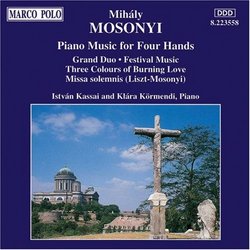| All Artists: Mihaly Mosonyi, Klára Körmendi, Istvan Kassai Title: Mosonyi: Piano Music for Four Hands Members Wishing: 0 Total Copies: 0 Label: Marco Polo Release Date: 10/4/1994 Genre: Classical Style: Opera & Classical Vocal Number of Discs: 1 SwapaCD Credits: 1 UPC: 730099355827 |
Search - Mihaly Mosonyi, Klára Körmendi, Istvan Kassai :: Mosonyi: Piano Music for Four Hands
 | Mihaly Mosonyi, Klára Körmendi, Istvan Kassai Mosonyi: Piano Music for Four Hands Genre: Classical
|
Larger Image |
CD Details |
CD ReviewsA Gratifying Arrangement of Liszt's "Gran Mass" Hexameron | 07/11/2007 (5 out of 5 stars) "Along with Erkel and Abranyi, Mihaly Mosonyi (1815-1870) is one of the elite Hungarian composers of the nineteenth century, although better known in his country than in other European regions. His music might not have reached international fame, but Liszt's approbation for his compositions is well-worth considering. Mosonyi showed Liszt gratitude in many ways, the most exemplary being his prodigious and impressive transcription of Liszt's "Gran Mass" for four hands. The beautiful and fervent music combined with Istvan Kassai's and Klara Kormendi's electrifying performance is enough to earn this Marco Polo release a solid five stars.
Some of Mosonyi's own compositions, however, are included beside his transcription of Liszt's "Gran Mass." The "Grand Duo" is essentially a piano sonata for four hands. Writing to the Hungarian composer Kornel von Abranyi, Liszt said, "Many of [Mosonyi's] Hungarian pieces remain classical, as opposed to the current wares..." Compared to contemporary works around 1847, the Grand Duo indeed sounds like something "between Viennese classicism and early Viennese romanticism," as the liner-notes writer says. The first movement is virtuosic and melodious, perhaps best described as a cross between Moscheles and Schubert. The middle movement, an innocent Allegretto, has occasional moments of Romantic lyricism and beauty, but the "Vivace" last movement certainly looks back to Classicism and even to the aesthetics of Beethoven. The "Three Colours of Burning Love," a collection of three miniatures, are not that interesting, but Mosonyi's "Festival Music" scores better with its Hungarian Rhapsody-like structure and mood. Mosonyi's transcription of Liszt's "Gran Mass" is the triumph of this recording. The Mass was written around 1855 for the "dedication of the Esztergom Cathedral" in Hungary. According to Humphrey Searle, "This work caused considerable discussion at the time; Liszt was accused of imitating Wagnerian methods in it, and even of trying to 'smuggle the Venusberg in church music.'" Those who have heard the Mass know the work contains many exciting and gorgeous ideas. Liszt's enthusiasm for the Mass and the recurrence and reworking of motifs in each movement make for compelling music. Douglas Townsend points out that "The principal theme of the 'Agnus Dei' of Liszt's [Gran Mass], incidentally, is announced by the basses, and was inspired by Mosonyi's playing." This four hand arrangement resounds with strength and captures all of the drama and introspection of the choral work. Dr. Dezso Legany, the liner-notes writer, shares a similar view: "Mosonyi aptly reflects the orchestral colours in his transcription, which Liszt himself could hardly have bettered." Bottom line: Mosonyi's compositions are pleasing enough diversions and the "Grand Duo" is a good, if admittedly average work. But Mosonyi's transcription of the mighty "Gran Mass" is a splendid and welcome homage to Liszt. The animated performance by the piano duo intensifies this music to such a high degree that the piano arrangement can, I think, stand on its own without reference to the choral Mass." |

 Track Listings (13) - Disc #1
Track Listings (13) - Disc #1